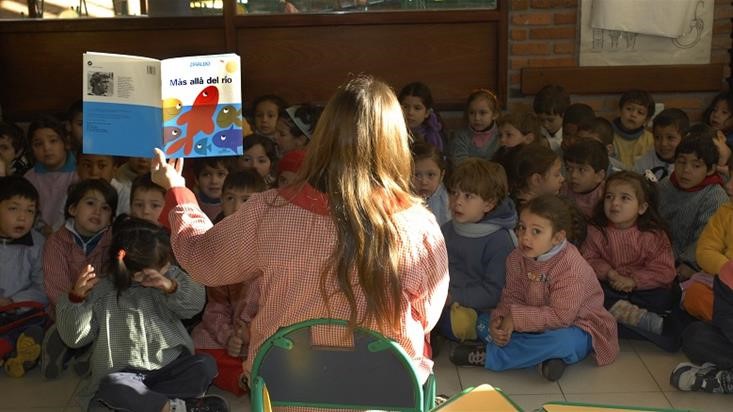

Storytelling time at a classroom.

When I was 13, my literature teacher Estela asked the class to look at two drawings and write down a story about each one them. I looked at the drawings: one was of a man in a suit and tie who was carrying a suitcase and wearing a watch. The other was of the same man but he had a beard, torn clothes and broken shoes. I wrote the first story about a successful man with an amazing family, the second about a poor, sad man who had no friends. Estela seemed disappointed and asked me if people are defined by their clothes. That day, my teacher spoke about prejudices and I learned something that I won’t forget.
Most of us remember at least one of our teachers. That woman or man who said something that left an impression on you when you were a child or a teenager. That person that did something memorable, led by example, challenged you, or simply helped you to become a better person.
World Teachers' Day, celebrated every year on October 5, focused this year on the right to education – and that means the right to qualified teachers. “The job of a teacher is not to passively teach, but to actively make sure that all students in the classroom learn,” Jaime Saavedra, who leads the Education Global Practice at the World Bank, said during a recent visit to Uruguay. “This is a huge responsibility.”
Teaching is the most important school-based determinant of student learning. That’s not just a simple statement. The difference between the impact of a weak and a great teacher on student test scores is equivalent to one to two years of schooling. Evidence suggests that several consecutive years of effective teaching can offset the learning shortfalls of marginalized students and significantly improve students’ long-term outcomes.
“The learning crisis is, at its core, a teaching crisis,” said Ezequiel Molina, an economist at the Global Knowledge and Innovation Team of the World Bank’s Education Global Practice.
Identifying effective teaching is not easy, however. Research shows that the characteristics of a teacher such as formal education, years of experience (beyond the first two), cognitive skills and entry exam performance only explain a small fraction of the fluctuation in student learning.
“Although better teaching practices are needed to tackle the learning crisis, most education systems in low- and middle-income countries do not regularly monitor them, either because they do not recognize the importance of such practices or do not know how to monitor them,” Ezequiel said.
So, how do you measure who is a good teacher? How do you improve teaching practices in a country? How do you distinguish between effective and ineffective teachers?
An answer is a tool called TEACH. Ezequiel, the Team Leader behind this new open-source tool for classroom observation, said TEACH was developed to address these challenges. First, it is the first tool to holistically measure what happens in the classroom by considering not just the time spent on learning but, more importantly, how the teacher teaches, or the quality of teaching practices. Second, TEACH captures the practices that nurture children’s cognitive and – for the first time – socioemotional skills. Third, the tool was developed with low- and middle-income countries in mind, and fourth, it includes a toolkit that facilitates data collection, analysis and scoring validation.
TEACH was piloted in over 1,000 classrooms across Mozambique, Pakistan, the Philippines and Uruguay, and tested with global video footage from 12 low- and middle-income countries. In Uruguay, the World Bank and the government there have already piloted TEACH as part of a wider strategy to improve teaching practices in early and primary education through the Improving the Quality of Initial and Primary Education Project.
Through observation, the tool evaluates specific variables such as classroom culture (how teachers create a culture conductive to learning), instruction (how teachers provide instruction in a way that deepens the students’ understanding and encourages critical thought and analysis), and how teachers foster socioemotional skills. A teacher who treats all students respectfully is better rated than one who constantly yells at or puts students on the spot. A teacher who checks for understanding to ensure most students comprehend the lesson gets higher scores than the one who does not or only asks self-reporting questions like “Did you understand?” or “Are you following along?”. Teachers who help students understand that failure and frustration are a normal part of the learning process are better rated than those who scold students for making mistakes.
The behaviors are rated as low, medium or high, based on the interactions observed in two, 15-minute observations in a classroom. These preliminary scores are translated into a five-point scale that quantifies the teacher’s pedagogical practices.
The tool will be launched soon. TEACH’s manual will be available in English, French, Spanish and Portuguese. The goal is to improve the capabilities of teachers, provide them with feedback and help them become that memorable person who will leave a mark on the children in their class. Just like my teacher Estela did.

